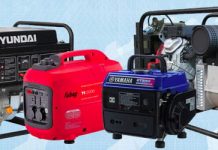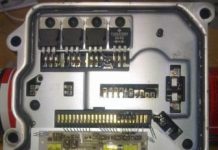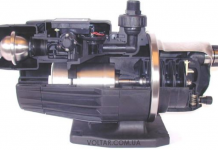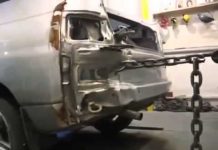Welding rectifiers are structurally similar to transformers, but they are additionally equipped with mechanisms that are inherent in inverter equipment (control module and diode rectifier). This state of affairs determines the peculiarities of their repair.
If the nodes of the power unit fail, they are repaired in the same way as welding transformers (rewinding coils, restoring insulation between cables, changing regulators and capacitors, etc.). But in case of breakdowns of the control unit and the diode rectifier, the state of the electrical circuit of the apparatus should be analyzed.
Semi-automatic welding equipment can be designed on the basis of rectifiers or inverters. As you yourself understand, it is necessary to repair such units according to the principles described above - the breakdowns will be identical. Note that during the operation of semiautomatic devices, mechanical breakdowns are often recorded, which are caused by wear of the wire feed device to the welding zone.
In the specified device, with the active use of welding equipment, increased friction between the channel and the supplied wire can be observed. This problem is solved by installing a new channel. It is better not to use other methods of restoring the normal functioning of the apparatus due to their low efficiency.
VIDEO
The inverter is used by experienced welders and hobbyists. It is a modern and convenient welding machine. It is more compact than a welding transformer and much lighter. Thanks to this, the inverter can be easily used in field and high-altitude works. The price of the device ranges from 3000 rubles. It's easy to use. The inverter is equipped with electronics to facilitate operation. Therefore, many newcomers to the welding business acquire it.
Unlike a transformer, which consists of electrical components, the inverter is equipped with electronics. The inverter transformer is very small, no bigger than a pack of cigarettes. If a 160 A welding transformer weighs about 20 kg, then the same transformer of a welding inverter weighs 250 g, which is why the inverter is so compact and lightweight.
All elements are enclosed in a metal case. A wide, adjustable shoulder strap is attached at the top. The device is comfortable to carry and rise to a height with it. The case has additional ventilation grilles for efficient cooling. The device has two connectors: "plus" and "minus". The ground cable and the electrode holder cable are connected to them. On the front of the body there is a control panel with an indicator for turning on the mains and an indicator for operating the protection against overheating, a button for turning on the mains and smooth adjustment of the welding current. Models with different welding modes have a mode switch. The inverter is connected to the grid using the power cable. The device has support legs at the base of the case.
Inverters stop working for four reasons:
Failure to comply with the conditions for the correct use of the device.
The operating mode is incorrectly selected.
Failure of the electronic components of the microcircuit.
Breakdown of electrical components of equipment such as wires and contacts.
To understand how to repair an inverter, let's figure out its circuits and the principle of operation.
The welding inverter consists of many elements.
Inverter operating principle:
An input alternating current with a frequency of 50 Hz passes through the mains rectifier 1 and is converted into direct current. Along the way, it is smoothed by a line filter 2, consisting of capacitors.
Problems related to operation and misalignment of the inverter:
The arc burns unevenly or too intensely, causing the electrode material to spatter heavily. This is due to an incorrectly selected welding current. When adjusting the current, it is necessary to take into account the thickness of the metal workpieces.With regard to this, select the type of electrode and its diameter. When purchasing electrodes, read the information on the packaging. The recommended current is indicated there. If this information is missing or the packaging is lost, then you can calculate the welding current yourself. First multiply 30, then 40 by the diameter of the electrode and get the welding current interval. For example: 30 * 3 mm = 90, 40 * 3 mm = 120. This means that the current range is from 90 A to 120 A. If the welding speed is low, then the current value must also be reduced. The welding electrode often sticks to the metal workpiece during operation. The main reason is undervoltage in the mains. If the inverter is designed for low voltage operation, then the cause of the problem may be the connection of the load, the level of which is below the minimum level. Or, in the panel sockets, there is a weak contact of the instrument modules. Tighten the fasteners. Voltage may drop at the input to the welder if you use an extension cable with a cross section of less than 2.5 square millimeters. If your extension cord is too long, more than 40 meters, then this also affects the voltage. In an electrical circuit, contacts oxidize or burn out over time. This affects tension. Another reason for adhesion of electrodes is the poor preparation of metal workpieces for welding. They must be thoroughly cleaned of paint and rust with a metal brush.
The inverter is turned on and the indicators show the same, but no welding is performed. This is due to overheating of the welding machine. Let it rest for at least an hour. If that doesn't help, then check the wires. They could disconnect themselves or fail due to an open circuit or short circuit.
If the mains voltage is constantly cut off, check the characteristics of the safety device, i.e. the circuit breaker. It is designed for a certain current strength. For correct operation of the welding inverter, a current of up to 25 A.
The machine does not turn on if the mains voltage is too low for welding work.
During continuous welding for a long time, the inverter is turned off. The device heats up to a certain level and the temperature sensor is triggered. However, this is not a malfunction. Turn off the inverter for 30 minutes and continue working.
Electronic components fail for the following reasons:
Moisture penetrates into the body of the welding inverter as a result of working in rain or snow without a canopy. When using the unit in a construction site, a lot of dust collects under the cabinet. This prevents proper cooling of the electronic components in the circuit. Clean the inverter regularly. The smaller the machine body, the smaller the cooling holes and the more often the inverter needs to be cleaned.
The electronics fail due to ignoring the manufacturer's recommended operating rules for the device. Read the instructions carefully and follow the rules.
Before starting to disassemble the device, check the correctness of all settings and read the instructions. There are indicated not only recommendations for the correct operation of the device, but also problems that are quickly eliminated on their own.
Unscrew the screws on the case and remove all parts. Diagnostics begins with a superficial examination of all elements and boards. There may be several of them:
Power transistor board.
Rectifier diode board.
Mains voltage rectification board.
You need to carefully look for burnt tracks and damaged elements. If no damage is found, then diagnose with a multimeter:
If the inverter does not turn on, put the multimeter in Continuous Mode and ring the power cord and power button pins. Check the charging resistor. If it is in a cliff, then the device will not work. The resistor is responsible for charging the capacitors.
Check power transistors.On the board, put the black probe on the left leg, and the red one on the right, then swap the probes. The ringing should go one way.
Place the black probe on the middle leg, and the red one on the left, then on the right. Ringing should be in both positions.
Transistors have a small resistance in hundredths of an Ohm. But they pass through themselves a current of several tens of amperes. To avoid overheating, they are installed on aluminum radiators. A badly damaged transistor is usually visible.
To replace the transistor, you first need to unscrew it from the radiator, and then dismantle the radiator itself from the board.
To solder the transistor from the board, you need to warm it up with a hairdryer. During dismantling, the tracks must not break.
The surface of the radiator for the new transistor must be well cleaned with alcohol and polished. The surface on the transistor should be smooth. Any blotch or grain of sand will create a gap between the transistor and the heatsink. It is unacceptable. Apply a very thin layer of heat-conducting paste to the surface of the transistor that will be in contact with the heatsink. When tightening the transistor, the paste should come out slightly from under the case. The thick layer will not come out and the transistor will deform. The component must be applied to the surface of the radiator and rub in in a circular motion so that it lies over the entire area. It should stick.
Screw the adhered transistor to the heatsink and insert into the board. Solder the legs.
If the transistor is out of order, it means that the elements of the driver board are damaged, which shakes the transistors.
All components of the board are called with a multimeter. The damaged ones are fed and changed.
Input and output rectifiers are made in the form of diode bridges. To prevent overheating, they are installed on radiators.
For diagnostics, it is unsoldered from the wires and dismantled from the board so as not to be mistaken in case of a short circuit in the circuit. Defective elements are replaced.
If the capacitor is discharged and we connect power to it, its resistance increases from zero. When fully charged, its resistance is equal to infinity.
Set the resistance mode in the multimeter to 20 kOhm.
If the device has recently been turned on, the capacitor has retained its charge. To determine if it is working properly, discharge the capacitor before testing. Connect the capacitor leads with a multimeter probe.
Connect the test leads of the multimeter to the capacitor leads. If the resistance was zero, then as the capacitor was charged from the multimeter, it increased to infinity, the capacitor was functioning.
But you still need to measure the voltage. Set the multimeter to DC voltage measurement in the 2000 mV range. Connect the test leads of the device to the capacitor leads. The device should show voltage. Short-circuit the capacitor leads and measure the voltage again. If it drops to zero, your capacitor is functional.
All elements of the welding machine depend on the control board.
This is the hardest block. It is diagnosed with an oscilloscope. Control signals are checked. If they do not arrive, all the elements are called with a multimeter and the damaged ones change.
VIDEO
If you learn how to independently identify and troubleshoot the welding inverter, you can avoid unnecessary repair costs at the service center.
Hello everyone! So, another report on the repair of electrical equipment. Today we have welding KAISER AC WELDER TURBO - 250M. This is not an inverter, which means the simplicity of design and reliability of such welding transformers ensure long-term operation in harsh conditions.
What are the symptoms: there is no spark, but the cooler works, and at first glance there is nothing else to complain about. Immediately he began to sin on the wires and almost guessed. I took a tester-multimeter, it has a function, dials, which is what we need.
To see the insides of the welding, you need to remove the cover - it's not so easy, the handle holds the transformer on two bolts, first unscrew them, then unscrew the rest of the bolts. And two bolts hid behind the wheels.Remove the cover and retaining ring from the wheel.
Then everything goes according to plan - the nickname of the wire and, to my surprise, everything is also in order. It turns out that the tire winding burned out. To believe, I cleaned the tire itself at the ends and rang the bell again - and again there is a resistance of 6 ohms, yes, either the tester is broken or I have toilets from fatigue.
Yes, the weak point of welding transformers is the terminal block to which the welding cables are connected. Poor contact together with a high welding current leads to strong heating of the connection and the wires connected to it. As a result, the connection itself is destroyed, the insulation at the ends of the windings burns out, from which a short circuit occurs.
I clean the bus and bring it out of the case with aluminum wires, since the bus is aluminum, and the copper wires are not very good contact and always burn out at their docking. Galvanic steam. So I found the problem. I know from experience that the bus is connected to the cable with a clamp. But I couldn't just twist it, but I can twist it with bolts. But I thought of replacing the wires for a long time with a longer one, the standard ones are 1 meter, agree a little, but this 5 meters is already something.
In a private house or garage, many users have a welding machine. It is needed in the household to repair inventory and create new products. High quality and tastefully made metal structures in skilled hands look like works of art.
What does a welding machine look like
Welding machines are used in industry and are irreplaceable where there is work with metal.
The operational reasons for the failure of the welding machine are as follows:
hit of precipitation, high humidity, violation of the temperature regime;
too low or high welding current;
ingress of contaminants inside: dust, oil, debris, metal particles;
deviation from the operating rules specified in the instructions.
Proper maintenance of the inverter is especially important.
The devices are the simplest of all used for welding. The main advantages of this type of welder are simplicity, unpretentiousness, reliability and relatively low price. The main disadvantages are large dimensions and weight.
Welding transformer - the easiest welding machine
Most of the device is occupied by a transformer. Its important parts are the contacts on the terminal block, to which the cables for welding are connected. At high currents, the reliability of the joints is important, since with their deterioration, intensive heating of the parts occurs.
Repair of welding transformers consists in disassembling joints, replacing burnt parts, stripping contacts and creating reliable insulation. Other malfunctions and solutions are as follows:
The welding machine must be equipped with a safety device that is triggered when the cooling system does not cope with prolonged operation.
In this case, the apparatus must "rest" for at least 30-40 minutes. If there is no protection, the machine is installed in the electrical panel. It must be correctly selected.
For each model, the instructions indicate the operating mode, for example, for the Interskol inverter, a break of 3-4 minutes is required. after 7-8 minutes. welding.
The simplest diagram of a welder with a rectifier is shown in the figure below, where a diode bridge and a capacitor are connected after the transformer. The device can be made by hand.
DC welding machine diagram
Power is supplied from a 220 V network. A 10 A fuse is connected to the primary winding. When it burns out, this is one of the faults that is easiest to fix by making a replacement. The SA1 machine for 16 A is also connected there.
The power section fails for the same reasons as the transformer. The electronic part, which includes the rectifier and the control unit, brings the device closer to the inverter. The diode bridge or other parts may fail.
A careful study of the causes and their elimination with your own hands will save significant money.
Inverter-type devices provide the highest welding quality, but are less reliable due to the high complexity of the electronic device. The figure below shows the device without a cover.
Inner part of inverter for welding
During the repair, radio components and the correct passage of signals through the modules are checked using an oscilloscope, multimeter and other measuring instruments.
A feature of finding a malfunction of electronic parts is the difficulty of identifying defects in appearance. Successful repairs can be done with experience with electrical wiring.
The welding inverter consists of modules, the main of which are the input and output rectifier, as well as the control board.
Principle of operation:
rectification of the supply alternating current;
converting direct current into alternating current with high frequency;
decrease in voltage to operating value;
rectification of current into direct current.
Inverter control board schematic
The modules are located in series one after the other, with the exception of the control system connected to the frequency converter.
Inverters often burn out transistors, and the inspection begins with them. Malfunctions can be seen by the burnt casing or leads (Fig. 5).
Damaged transistor in the welding machine
All transistors are called with a multimeter. The discovered keys change. To improve heat dissipation, installation is carried out with thermal grease. Finding the right element can be tricky. Therefore, instead of faulty electronic parts, analogues are selected.
Transistors have sufficient power, and the reason for their destruction is the failure of other elements. They also need to be found and replaced. Rectifier diodes can be punctured. Before dialing, you must first unsolder the wires from them.
The most complex module of the device is the control board, which is repaired by specialists. The passage of signals through the circuits is checked.
If repairs can be made, a significant amount of money will be saved.
VIDEO
Video (click to play).
A modern welding machine is a complex system that must be operated according to all the rules. For the most part, specialists are invited for repairs, but simple breakdowns can be eliminated on your own. Inverter machines greatly simplify the welding process, but are more demanding for proper maintenance and operation.









